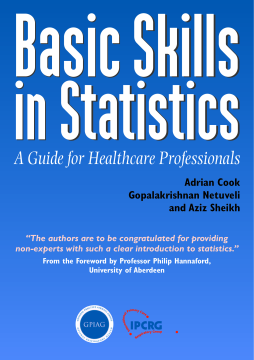
Additional Information
Book Details
Abstract
Statistics can be an intimidating subject for many students and clinicians.
This concise text introduces the basic concepts that underpin medical statistics, and using everyday clinical examples, highlights the importance of statistical principles to understanding and implementing research findings in routine clinical care.
This book will be an essential tool for students, clinicians in training, nurses and GPs.
Table of Contents:
Part 1 Introduction
Part 2 Laying the foundations: measure and probability
Part 3 Description of a single variable
Part 4 Linking two variables
Part 5 Statistical inference
Part 6 Study design
Part 7 Combining studies: systematic reviews and meta-analyses
Part 8 Managing data
Table of Contents
| Section Title | Page | Action | Price |
|---|---|---|---|
| Cover | Cover A | ||
| Contents | v | ||
| Foreword | vii | ||
| Introduction | 1 | ||
| Chapter 1 Laying the foundations: measurement and probability | 3 | ||
| The building blocks of statistics | 3 | ||
| Measurement | 4 | ||
| Types of data | 9 | ||
| Probability | 11 | ||
| Summary | 14 | ||
| Chapter 2 Description of a single variable | 15 | ||
| Minimum information needed to describe a variable | 15 | ||
| Distributions of variables | 16 | ||
| Probability distribution function for a numerical continuous variable | 19 | ||
| Summarising data | 20 | ||
| When not to summarise | 23 | ||
| Summary | 25 | ||
| Chapter 3 Linking two variables | 27 | ||
| Key messages | 27 | ||
| Univariate, bivariate and multivariate statistics | 28 | ||
| Association and causation | 28 | ||
| Relationship between two continuous variables | 29 | ||
| Relationship between two categorical variables | 34 | ||
| Summary | 39 | ||
| Chapter 4 Statistical inference | 40 | ||
| Key messages | 40 | ||
| What is statistical inference? | 41 | ||
| Estimation | 41 | ||
| Hypothesis-testing | 42 | ||
| P values: uses and limitations | 44 | ||
| Testing hypotheses between continuous variables | 45 | ||
| Hypothesis-testing between categorical variables | 47 | ||
| Summary | 51 | ||
| Chapter 5 Study design | 53 | ||
| Key messages | 53 | ||
| The need for clear study objectives and outcome measures | 54 | ||
| Choice of study design | 55 | ||
| Sample size calculations | 57 | ||
| Summary | 63 | ||
| Chapter 6 Combining studies: systematic reviews and meta-analyses | 64 | ||
| Key messages | 64 | ||
| Why do we need systematic literature reviews? | 65 | ||
| Steps in conducting a systematic review | 65 | ||
| Meta-analysis | 75 | ||
| Summary | 77 | ||
| Chapter 7 Managing data | 78 | ||
| Key messages | 78 | ||
| Data collection | 79 | ||
| Organising data | 79 | ||
| Data entry | 80 | ||
| Choosing a statistical package | 83 | ||
| Transferring data between packages | 84 | ||
| Repeatable results | 84 | ||
| Summary | 85 | ||
| Glossary | 87 | ||
| References and further reading | 95 | ||
| Index | 98 |
